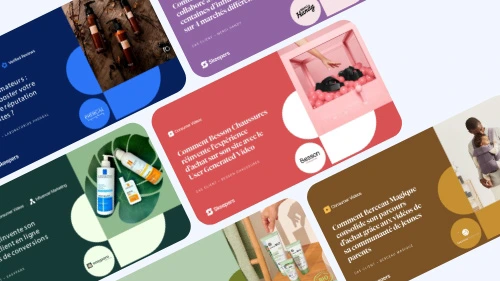The Covid-19 worldwide pandemic, which appeared at the beginning of 2020, has brought multiple changes to our daily lives. Unquestionably, we had to readjust our routine and re-evaluate our needs according to the situation. Among the main changes, this crisis has considerably increased the use of social networks: in 2020, the average time spent on social media was 65 minutes per day, compared to 56 in 2019. The rise of Social Media in 2020, has, in its momentum, brought a clear increase in Social Shopping.
How to commercialize via social networks? How to use influencers to boost your Social Shopping strategy? Zoom on this booming sector.
Social networks, facilitators of e-commerce
The year 2020 has undeniably changed our way of consuming: the closing of all shops except supermarkets and drugstores has in a way obliged us, the consumers, to buy online.
From a foreign habit for some, this act has become routine and anchored in the daily habits: It is estimated that the e-commerce sector will reach a total revenue of 5.4 trillion US dollars by 2022.
Social networks have also experienced a massive development accelerated by the Covid-19 pandemic: these platforms count 4.2 billion users worldwide according to a study conducted by We Are Social and Hootsuite. Thousands of publications, photos or videos are published every day on networks such as Instagram, Snapchat, Facebook, and many others. Always with the idea of going further in the e-commerce experience and making it as optimal as possible, these networks have successively deployed their own marketplaces, revolutionizing the e-commerce sector.
This explains the emergence of Social Shopping, which is the use of social networks to generate sales. This marketing concept aims at facilitating online consumption, by allowing the user to buy directly via the relevant network. It is estimated that 48% of people aged between 18 and 34 years have already made a purchase on a social network.
Which social networks to adopt for your Social Shopping strategy?
Facebook and Instagram
Brands have many features to facilitate and encourage online shopping. To do so, the Web giants Facebook and Instagram have both developed their own marketplaces. Thus, shopping directly on the social network concerned is possible via the dedicated Marketplace tab. Choose the product category you’re looking for, and scroll endlessly to find the rare gem.


Photo credits : Facebook and Instagram marketplace
Instagram Shopping, developed in 2018, offers business accounts to tag products displayed on a publication. These tags redirect the user straight to the webpage of the product concerned: this is called “drive to website” (redirecting a consumer to the website). Brands can tag up to 5 products per post, maximizing their conversion goals.
In November 2020, the social network also launched a Live Shopping feature, offering users the ability to make purchases during an Instagram Live. Again, brands can showcase up to 30 products during the live and tag them, making it very easy for consumers to identify items, and purchase via the platform.
In the digital age, where the act of payment can be done directly from a phone without taking out a credit card, social networks are also adopting easy payment technology. For example, last year Facebook launched its own payment method to further optimize the customer journey. Owner of the Instagram, Messenger and WhatsApp networks, Facebook wanted to make it as easy as possible to buy on its platform by developing its own payment method. Facebook Pay allows users to pay directly on the social network, and even send transactions to friends and family via Messenger. This feature collects consumers’ data in a secure way to allow them to make purchases simply and quickly.
The American leader does not plan to stop there: a “Creator Week” was organized the week of June 8 to 10, 2021, to present new Instagram features. These features, always with the intention of facilitating the path to purchase via e-commerce, should allow users to sell products directly via their profiles, to earn commissions on their sales, and many others. To be continued…
TikTok
TikTok, an application that has become very popular over the last few months, keeps on renewing itself. The social network specialized in videos has the ambition to develop features focused on e-commerce. Among them, a marketplace tab could be added to the user profile, as well as the possibility to do Live Shopping, allowing to buy directly on the platform. These new features are currently being tested in the UK.
From an inspirational platform, Pinterest has transformed into a real sales platform. Among the many features it offers, brands can get the “verified merchant” badge and display their product catalog directly on their profile. A “Buy” section allows users to purchase a product via the platform, but also to filter their searches by price category and brand. Primarily an inspirational network, Pinterest allows users to take a photo of an item, and suggests products similar to the one in the photo, available on the social network.

Snapchat
Snapchat is also developing its e-commerce offer: focused on augmented reality features, users can try products (accessory, makeup, clothing) directly on themselves with the camera of their phone.
In the same idea as Pinterest, the platform allows you to take a photo via the Scan tool and offers product recommendations based on the photo, thanks to the Screenshop feature. As you can see, social networks are becoming real shopping platforms, focusing their Social Shopping strategy on a constant improvement of the user journey.
Netflix
Netflix, the king of streaming, recently launched its online store, Netflix Shop. This new feature allows the brand to extend its activity beyond the production of movies and series. Users can purchase limited edition items from collections inspired by the series offered on the platform.
Influencer marketing, a considerable asset for e-commerce
Brands have every interest in using social networks as a sales medium by relying on influencer marketing to achieve various objectives. As an example, here is what a Social Shopping strategy can achieve:
- Increase your online visibility thanks to the virality and influence of social networks;
- Adapting your business to digital, an essential marketing lever in 2021;
- Answer the needs of a modernized audience more and more seduced by online shopping;
- Boost sales by facilitating the customer experience and the purchasing process;
- Enriching content through the exposure of products on different platforms.
Complementary to e-commerce, influencer marketing, an essential sector of social networks, has grown considerably during the various lockdown periods, resulting in a lack of social interaction. Micro- and nano-influencers have thus strengthened their relationship of proximity and trust with their followers. Keeping an eye on the daily life of their favorite influencers, these subscribers closely follow their activities, trips or outfits posted every day on the networks.
Brands, aware of the major asset that this sector represents, are more and more numerous to collaborate with influencers, a guarantee of authenticity and sincerity.
Social networks are proving to be a real facilitator of online commerce, supported by a range of developed features, allowing brands to generate sales. But the efficiency of a Social Media strategy requires a good knowledge of its audience in order to address a personalized message.
Boost your strategy with consumer reviews, a guide to online shopping
Consumer reviews have become a must-have for brands and represent a considerable asset in the purchasing act. Increasingly appreciated and researched by users, consulting reviews has almost become a post-purchase automatism.
Influencers have seen their prescription power increase as well as their relationships with their subscribers have strengthened during periods of lockdown, supported by a need to socialize.
Users, attentive to the opinions of influencers, tend to buy a product recommended by them much more easily. According to a survey conducted by Hivency with 3,833 consumers and users of the Lucette platform, 85% of consumers made a purchase after seeing an influencer’s post. These users are also active on social networks: they post content, interact with influencers, like, comment on posts…
Collected on merchant sites, forums or applications, consumer reviews feed the user experience: a source of valuable information about a product or service, they guide consumers in their purchases.
Real ambassadors for brands, influencers are increasingly solicited by retailers to test products and give their opinions. Brands attach great importance to these consumer opinions, which are a goldmine for improving their offer and taking into account their customers’ needs. Following brand/influencer collaboration, these reviews can be reused to feed the brands’ commercial content such as product sheets, the website, the official Instagram account…
Everything is good to make the shopping experience as optimal as possible.
Photo credits : rupixen.com via Unsplash


















